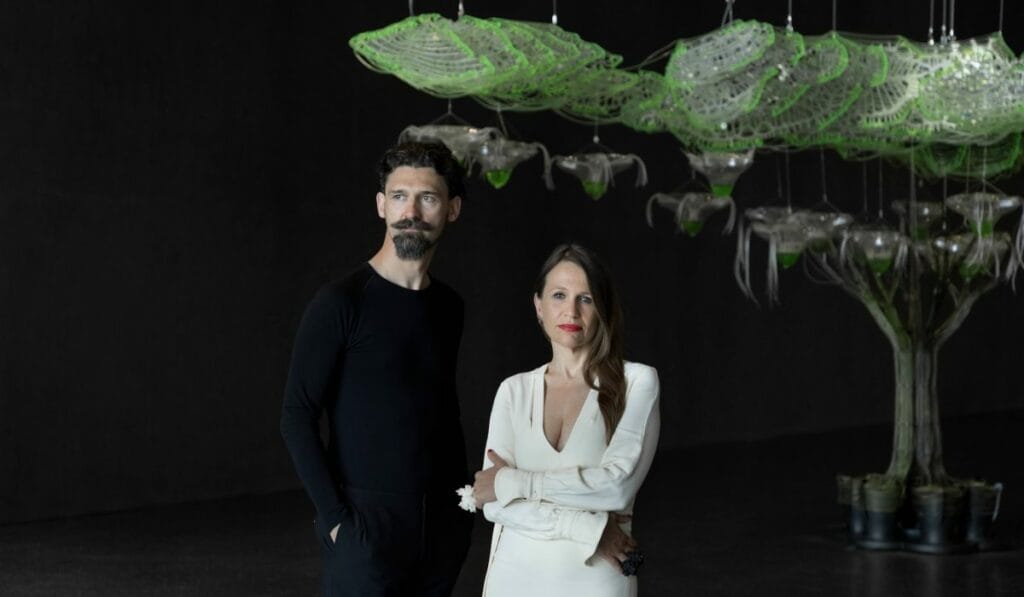By Kenneth Lee
In the realm of scientific advancement, algae might quite possibly be one of the least sexy sounding mediums. After all, the mention of algae conjures up vivid imagery of stained fish tanks or stagnant brooks. Yet, the organism holds a million years of evolutionary potential just waiting to be tapped – which is exactly what London-based Ecologicstudio is doing.
The design and architecture studio, founded by Claudia Pasquero and Marco Poletto in 2005, have centred their practice around the creation of biophilic design – a design that’s focused on bridging the gap between humanity and nature.
They recently unveiled Airbubble in Poland’s capital city, Warsaw (so chosen, incidentally, for its status as one of Europe’s most polluted cities). It is a visceral example of the firm’s commitment to blending microalgae and urban architecture in a pleasing way.

Dubbed the world’s first ‘biotechnological’ playground, Airbubble is a cylindrical play pavilion that’s purported to purify the entire volume of air by way of 52 glass-bound microalgae bioreactors around the space.
These bioreactors contain 520 litres of living green chlorella algae cultures that claim to filter polluted air at the rate of 200 litres a minute, effectively reducing the amount of fine particulate matter (PM2.5) in the microclimate to levels well within the World Health Organization’s guidelines in the span of a day. Apart from absorbing atmospheric pollutants, algae also turn carbon dioxide into oxygen via a nifty process called photosynthesis.
Naturally, this is dependent on the amount of sunlight the organisms are getting, as well as the frequency of play in the pavilion. The ropes, bouncy spheres and foot pedal pumps in the playground also help get the algae moving; an air pump ensures the bioreactors get what they need otherwise.

The studio has also incorporated some previous tech they’ve developed – a proprietary membrane that controls the microclimate, with some openings at the top of the pavillion for air flow to control heat and moisture in the space.
Apart from being a showcase of Ecologicstudio’s advancements – as well as a statement on the primary victims of polluting the world, namely the children – the Airbubble will act as a testbed for future biophilic developments within its space at the Copernicus Science Centre (which is also hosting an exhibition to explain the structure).
A self-sufficient air filter (of sorts) that’s easy to maintain and scale can only spell benefits for the world of sustainability at large – especially when considering the myriad uses of algae. Some species can be used as biofuel, or sometimes, even sustenance.
“We can look at algae as biomass and organisms that are some of the oldest in the biosphere. They’ve evolved to have a sophisticated biological intelligence, which makes them capable of growing in pretty much any environment – even a contaminated one. For algae, contaminants are nutrients: algae can re-metabolize pretty much anything. As a consequence, the biomass that we extract from algae has properties that can be used in several industries,” says the founders.

A previous project by Ecologicstudio, the Bit.Bio.Bot exhibition, explores just that. You’ve probably heard of spirulina, a blue-green algae that’s normally taken in tablet form. Apart from containing a slew of vitamins and antioxidants, it’s also incredibly nutritious gram-for-gram. The exhibition, which was unveiled at the Venice Architecture Biennale earlier this year, presented three applications of the firm’s algae-growing tech.
The first is what the studio dubs Photosynthetica curtains, which sort of work like a second, eco-friendly skin to be draped over buildings – similar to the glass-clad bioreactors mentioned earlier, but wrapped with a see-through membrane. The pattern of algae within the membrane was made at this exhibition to resemble the nearby brickwork, while increasing its potential as a shading and carbon-scrubbing medium (more surface area, more oxygen).
The second was a vertical garden to encourage budding algae farmers, and the final was a table where visitors could sample the, well, algae on display. After all, chlorella and spirulina, both varietals used in the exhibition, are already commonly consumed – though usually in tablet form, as health supplements. They’re incredibly nutritious gram-for-gram on the antioxidant, vitamin and protein front, which makes them an excellent avenue for further exploration to solve our growing nutritional needs.
These possibilities include training “an algorithm to behave like a slime mould”.

They explain further: “One of the biological models we’re looking at that’s really incredible. It’s a monocellular organism that creates networks to reach out to nutrients and distribute them. It’s a fascinating creature; even scientists still don’t understand exactly how it works.”
“From a biological point of view, we think that algae are one of those organisms that present a kind of unexplored layer of the bio-sphere. They’re already inhabiting our cities and are just waiting to be incorporated,” the founders continue.
For more on Ecologicstudio.



